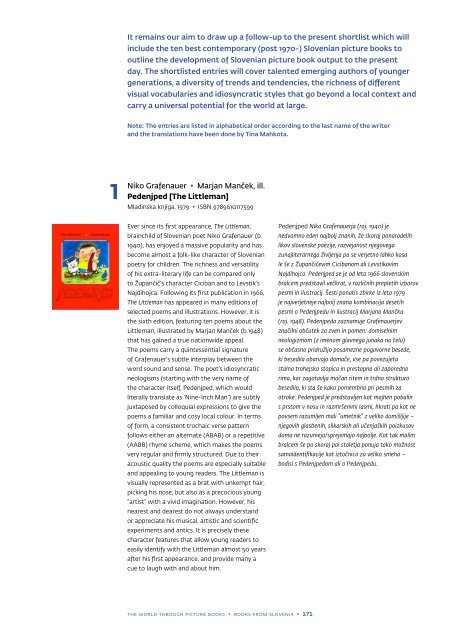world_pictures
world_pictures
world_pictures
Create successful ePaper yourself
Turn your PDF publications into a flip-book with our unique Google optimized e-Paper software.
It remains our aim to draw up a follow-up to the present shortlist which will<br />
include the ten best contemporary (post 1970-) Slovenian picture books to<br />
outline the development of Slovenian picture book output to the present<br />
day. The shortlisted entries will cover talented emerging authors of younger<br />
generations, a diversity of trends and tendencies, the richness of different<br />
visual vocabularies and idiosyncratic styles that go beyond a local context and<br />
carry a universal potential for the <strong>world</strong> at large.<br />
Note: The entries are listed in alphabetical order according to the last name of the writer<br />
and the translations have been done by Tina Mahkota.<br />
1<br />
Niko Grafenauer • Marjan Manček, ill.<br />
Pedenjped [The Littleman]<br />
Mladinska knjiga, 1979 • ISBN 9789610117599<br />
Ever since its first appearance, The Littleman,<br />
brainchild of Slovenian poet Niko Grafenauer (b.<br />
1940), has enjoyed a massive popularity and has<br />
become almost a folk-like character of Slovenian<br />
poetry for children. The richness and versatility<br />
of his extra-literary life can be compared only<br />
to Župančič’s character Ciciban and to Levstik’s<br />
Najdihojca. Following its first publication in 1966,<br />
The Littleman has appeared in many editions of<br />
selected poems and illustrations. However, it is<br />
the sixth edition, featuring ten poems about the<br />
Littleman, illustrated by Marjan Manček (b.1948)<br />
that has gained a true nationwide appeal.<br />
The poems carry a quintessential signature<br />
of Grafenauer’s subtle interplay between the<br />
word sound and sense. The poet’s idiosyncratic<br />
neologisms (starting with the very name of<br />
the character itself, Pedenjped, which would<br />
literally translate as ‘Nine-Inch Man’) are subtly<br />
juxtaposed by colloquial expressions to give the<br />
poems a familiar and cosy local colour. In terms<br />
of form, a consistent trochaic verse pattern<br />
follows either an alternate (ABAB) or a repetitive<br />
(AABB) rhyme scheme, which makes the poems<br />
very regular and firmly structured. Due to their<br />
acoustic quality the poems are especially suitable<br />
and appealing to young readers. The Littleman is<br />
visually represented as a brat with unkempt hair,<br />
picking his nose, but also as a precocious young<br />
“artist” with a vivid imagination. However, his<br />
nearest and dearest do not always understand<br />
or appreciate his musical, artistic and scientific<br />
experiments and antics. It is precisely these<br />
character features that allow young readers to<br />
easily identify with the Littleman almost 50 years<br />
after his first appearance, and provide many a<br />
cue to laugh with and about him.<br />
Pedenjped Nika Grafenauerja (roj. 1940) je<br />
nedvomno eden najbolj znanih, že skoraj ponarodelih<br />
likov slovenske poezije, razvejanost njegovega<br />
zunajliterarnega življenja pa se verjetno lahko kosa<br />
le še z Župančičevim Cicibanom ali Levstikovim<br />
Najdihojco. Pedenjped se je od leta 1966 slovenskim<br />
bralcem predstavil večkrat, v različnih prepletih izborov<br />
pesmi in ilustracij. Šesti ponatis zbirke iz leta 1979<br />
je najverjetneje najbolj znana kombinacija desetih<br />
pesmi o Pedenjpedu in ilustracij Marjana Mančka<br />
(roj. 1948). Pedenjpeda zaznamuje Grafenauerjev<br />
značilni občutek za zven in pomen: domiselnim<br />
neologizmom (z imenom glavnega junaka na čelu)<br />
se občasno pridružijo posamezne pogovorne besede,<br />
ki besedila obarvajo domače, vse pa povezujeta<br />
stalna trohejska stopica in prestopna ali zaporedna<br />
rima, kar zagotavlja močan ritem in trdno strukturo<br />
besedila, ki sta še kako pomembna pri pesmih za<br />
otroke. Pedenjped je predstavljen kot majhen pobalin<br />
s prstom v nosu in razmršenimi lasmi, hkrati pa kot ne<br />
povsem razumljen mali “umetnik” z veliko domišljije –<br />
njegovih glasbenih, slikarskih ali učenjaških poizkusov<br />
doma ne razumejo/sprejemajo najbolje. Kot tak malim<br />
bralcem še po skoraj pol stoletja ponuja tako možnost<br />
samoidentifikacije kot iztočnico za veliko smeha –<br />
bodisi s Pedenjpedom ali o Pedenjpedu.<br />
the <strong>world</strong> through picture books • books from slovenia • 171


